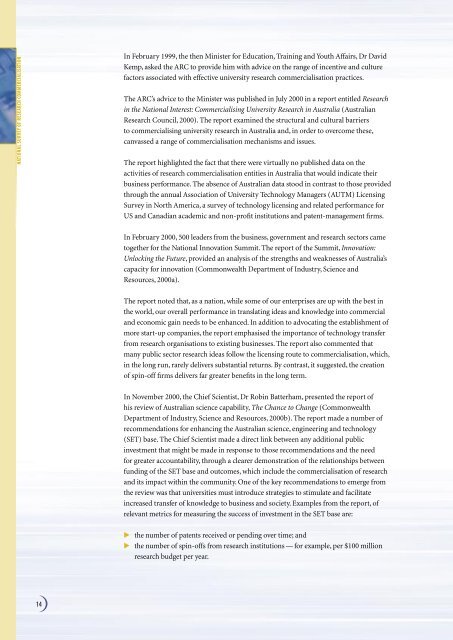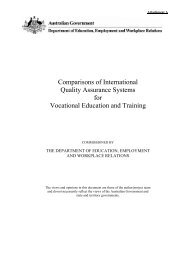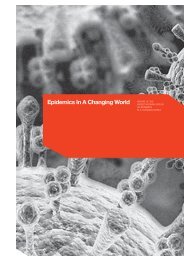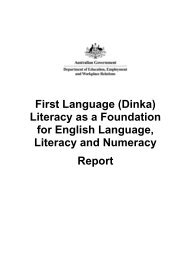National Survey of Research Commercialisation - Australian ...
National Survey of Research Commercialisation - Australian ...
National Survey of Research Commercialisation - Australian ...
Create successful ePaper yourself
Turn your PDF publications into a flip-book with our unique Google optimized e-Paper software.
NATIONAL SURVEY OF RESEARCH COMMERCIALISATION<br />
In February 1999, the then Minister for Education, Training and Youth Affairs, Dr David<br />
Kemp, asked the ARC to provide him with advice on the range <strong>of</strong> incentive and culture<br />
factors associated with effective university research commercialisation practices.<br />
The ARC’s advice to the Minister was published in July 2000 in a report entitled <strong>Research</strong><br />
in the <strong>National</strong> Interest: Commercialising University <strong>Research</strong> in Australia (<strong>Australian</strong><br />
<strong>Research</strong> Council, 2000). The report examined the structural and cultural barriers<br />
to commercialising university research in Australia and, in order to overcome these,<br />
canvassed a range <strong>of</strong> commercialisation mechanisms and issues.<br />
The report highlighted the fact that there were virtually no published data on the<br />
activities <strong>of</strong> research commercialisation entities in Australia that would indicate their<br />
business performance. The absence <strong>of</strong> <strong>Australian</strong> data stood in contrast to those provided<br />
through the annual Association <strong>of</strong> University Technology Managers (AUTM) Licensing<br />
<strong>Survey</strong> in North America, a survey <strong>of</strong> technology licensing and related performance for<br />
US and Canadian academic and non-pr<strong>of</strong>it institutions and patent-management firms.<br />
In February 2000, 500 leaders from the business, government and research sectors came<br />
together for the <strong>National</strong> Innovation Summit. The report <strong>of</strong> the Summit, Innovation:<br />
Unlocking the Future, provided an analysis <strong>of</strong> the strengths and weaknesses <strong>of</strong> Australia’s<br />
capacity for innovation (Commonwealth Department <strong>of</strong> Industry, Science and<br />
Resources, 2000a).<br />
The report noted that, as a nation, while some <strong>of</strong> our enterprises are up with the best in<br />
the world, our overall performance in translating ideas and knowledge into commercial<br />
and economic gain needs to be enhanced. In addition to advocating the establishment <strong>of</strong><br />
more start-up companies, the report emphasised the importance <strong>of</strong> technology transfer<br />
from research organisations to existing businesses. The report also commented that<br />
many public sector research ideas follow the licensing route to commercialisation, which,<br />
in the long run, rarely delivers substantial returns. By contrast, it suggested, the creation<br />
<strong>of</strong> spin-<strong>of</strong>f firms delivers far greater benefits in the long term.<br />
In November 2000, the Chief Scientist, Dr Robin Batterham, presented the report <strong>of</strong><br />
his review <strong>of</strong> <strong>Australian</strong> science capability, The Chance to Change (Commonwealth<br />
Department <strong>of</strong> Industry, Science and Resources, 2000b). The report made a number <strong>of</strong><br />
recommendations for enhancing the <strong>Australian</strong> science, engineering and technology<br />
(SET) base. The Chief Scientist made a direct link between any additional public<br />
investment that might be made in response to those recommendations and the need<br />
for greater accountability, through a clearer demonstration <strong>of</strong> the relationships between<br />
funding <strong>of</strong> the SET base and outcomes, which include the commercialisation <strong>of</strong> research<br />
and its impact within the community. One <strong>of</strong> the key recommendations to emerge from<br />
the review was that universities must introduce strategies to stimulate and facilitate<br />
increased transfer <strong>of</strong> knowledge to business and society. Examples from the report, <strong>of</strong><br />
relevant metrics for measuring the success <strong>of</strong> investment in the SET base are:<br />
the number <strong>of</strong> patents received or pending over time; and<br />
the number <strong>of</strong> spin-<strong>of</strong>fs from research institutions — for example, per $100 million<br />
research budget per year.<br />
14

















